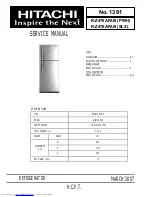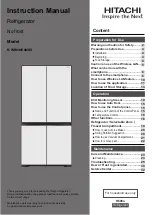
11
Normal Sounds
Your new refrigerator may make sounds that your old one didn’t
make. Because the sounds are new to you, you might be
concerned about them. Most of the new sounds are normal. Hard
surfaces, such as the floor, walls, and cabinets, can make the
sounds seem louder. The following describes the kinds of sounds
and what may be making them.
■
If your refrigerator is equipped with an ice maker, you will hear
a buzzing sound when the water valve opens to fill the ice
maker for each cycle.
■
Your refrigerator is designed to run more efficiently to keep
your food items at the desired temperatures and to minimize
energy usage. The high efficiency compressor and fans may
cause your refrigerator to run longer than your old one. You
may also hear a pulsating or high-pitched sound from the
compressor or fans adjusting to optimize performance.
■
You may hear the evaporator fan motor circulating air through
the refrigerator and freezer compartments. The fan speed
may increase as you open the doors or add warm food.
■
Rattling noises may come from the flow of refrigerant, the
water line, or items stored on top of the refrigerator.
■
Water dripping on the defrost heater during a defrost cycle
may cause a sizzling sound.
■
As each cycle ends, you may hear a gurgling sound due to
the refrigerant flowing in your refrigerator.
■
Contraction and expansion of the inside walls may cause a
popping noise.
■
You may hear air being forced over the condenser by the
condenser fan.
■
You may hear water running into the drain pan during the
defrost cycle.
REFRIGERATOR USE
Ensuring Proper Air Circulation
In order to ensure proper temperatures, you need to permit air to
flow between the two sections. Cold air enters the bottom of the
freezer section and moves up. It then enters the refrigerator
section through the top vent. Air then returns to the freezer as
shown.
Do not block any airflow vents. If the vents are blocked, airflow
will be obstructed and temperature and moisture problems may
occur.
IMPORTANT: Because air circulates between both sections, any
odors formed in one section will transfer to the other. You must
thoroughly clean both sections to eliminate odors. To avoid odor
transfer and drying out of food, wrap or cover foods tightly.
Using the Controls
For your convenience, your refrigerator controls are preset at the
factory. When you first install your refrigerator, make sure that the
controls are still preset. The Refrigerator Control and the Freezer
Control should both be set to the “mid-settings.”
IMPORTANT:
■
Your product will not cool when the REFRIGERATOR Control
is set to OFF.
■
The Refrigerator Control adjusts the refrigerator compartment
temperature. The Freezer Control adjusts the freezer
compartment temperature. Settings to the left of the mid-
setting make the temperature less cold. Settings to the right
of the mid-setting make the temperature colder.
■
Wait 24 hours before you put food into the refrigerator. If you
add food before the refrigerator has cooled completely, your
food may spoil.
NOTE: Adjusting the Refrigerator and Freezer Controls to a
higher (colder) than recommended setting will not cool the
compartments any faster.
Adjusting Controls
Give the refrigerator time to cool down completely before adding
food. It is best to wait 24 hours before you put food into the
refrigerator. The settings indicated in the previous section should
be correct for normal household refrigerator usage. The controls
are set correctly when milk or juice is as cold as you like and
when ice cream is firm.
Turn the control right (clockwise) to make the compartment
colder. Turn the control left (counterclockwise) to make it less
cold. To turn the cooling system off, turn the Refrigerator Control
counterclockwise until it reaches the OFF position.
If you need to adjust temperatures in the refrigerator or freezer,
use the settings listed in the chart below as a guide. Wait at least
24 hours between adjustments.
CONDITION/REASON:
ADJUSTMENT:
REFRIGERATOR too warm
REFRIGERATOR Control
one setting higher
FREEZER too warm/
too little ice
FREEZER Control
one setting higher
REFRIGERATOR too cold
REFRIGERATOR Control
one setting lower
FREEZER too cold
FREEZER Control
one setting lower












































